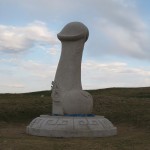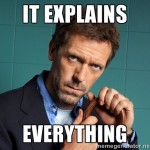Neo-Paganism has multiple centers, including Earth, Deity, and Self. This is the sixth in an 8-part series that explores Neo-Paganism as a Self-Centric “mystery religion”. This essay was originally published at Neo-Paganism.org.

“We need not even risk the adventure alone; for the heroes of all time have gone before us; the labyrinth is thoroughly known; we have only to follow the thread of the hero-path. And where we had thought to find an abomination, we shall find a god; where we had thought to slay another, we shall slay ourselves; where we had thought to travel outward, we shall come to the center of our own existence; where we had thought to be alone, we shall be with all the world.”
— Joseph Campbell
Joseph Campbell was a student of comparative mythology and religion. He was Carl Jung’s disciple and perhaps Jung’s most famous popularizer. Campbell is perhaps most well known for his The Power of Myth interviews with Bill Moyers on PBS, which aired in 1988, and for his influence on George Lucas, the creator of Star Wars. In the context of Neo-Paganism, Campbell’s most important idea was the “Monomyth”, which he explained in his book, The Hero with a Thousand Faces. According to Campbell, many of the world’s myths and folktales follow the pattern of the Monomyth.
In its broadest outline, the Monomyth or Hero’s Journey takes the form of a descent (katabasis) into and return (anabasis) from an underworld, whether real or metaphorical, a descenscus averni or “descent into hell” followed by a miraculous return. According to Campbell, this Journey involves three stages: “a separation from the world, a penetration into some source of power, and a life-enhancing return.” These stages correspond to the stages of all rites de passage described by anthropologist, Arnold van Gennep: a separation from the community, a liminal phase of transition, and a reintegration with the community having attained a new status.
According to Campbell, the first stage, separation, involves a call to adventure by a herald of some sort. The hero may descend willingly or may refuse the call. Typically, there is some form of supernatural intervention, a testing by guardians of the threshold, and a crossing of the threshold. The hero may defeat or conciliate threshold guardian or may be slain and descend in death. The crossing is a step into the unknown, a plunge into the “belly of the whale”. The second stage involves a series of trials. He may be aided by divine helpers. The test may take the form of the hero’s assimilation of his opposite or shadow self, or it may be a temptation to abandon the quest, perhaps by a literal temptress, a negative image of the feminine archetype. When he arrives at the nadir of the mythological round, the hero undergoes a supreme ordeal and gains his reward. The triumph may be represented as the hero’s sexual union (hieros gamos) with the divine feminine, his atonement with a father figure, attainment of an ultimate boon like immortality, or an expansion of consciousness (enlightenment). In the last stage, the hero may have to flee a vengeful force or may have to be rescued, he encounters the last threshold guardian, and then returns to the mundane world carrying with him some part of the divine world, either literally or within him. James Frazer’s myth of the Dying and Reviving God is a special type of the Monomyth.

“The idea that the passage of the magical threshold is a transit into a sphere of rebirth is symbolized in the worldwide womb image of the belly of the whale. The hero, instead of conquering or conciliating the power of the threshold, is swallowed into the unknown and would appear to have died. This popular motif gives emphasis to the lesson that the passage of the threshold is a form of self-annihilation. Instead of passing outward, beyond the confines of the visible world, the hero goes inward, to be born again. The disappearance corresponds to the passing of a worshipper into a temple – where he is to be quickened by the recollection of who and what he is, namely dust and ashes unless immortal. The temple interior, the belly of the whale, and the heavenly land beyond, above, and below the confines of the world, are one and the same. That is why the approaches and entrances to temples are flanked and defended by colossal gargoyles: dragons, lions, devil-slayers with drawn swords, resentful dwarfs, winged bulls. The devotee at the moment of entry into a temple undergoes a metamorphosis. Once inside he may be said to have died to time and returned to the World Womb, the World Navel, the Earthly Paradise. Allegorically, then, the passage into a temple and the hero-dive through the jaws of the whale are identical adventures, both denoting in picture language, the life-centering, life-renewing act.”
Campbell speaks of the hero as masculine, because the hero represents the ego, which is archetypal masculine, in contrast with the unconscious, which is archetypally feminine, but the hero may be male or female. One of the most popular pagan myths among Neo-Pagans is the Sumerian/Babylonian myth of the descent of Inanna/Ishtar into the underworld. In one version, Ishtar goes to the underworld in search of her dead consort, Tammuz. When she leaves the upper world, all procreative life falters. Ishtar must pass through seven gates and at each gate she surrenders one of her veils or one of her divine attributes, until she stands naked before the Queen of the Dead, her shadow self. She is rescued by divine intervention and guile and returns to the upper world bringing with her renewed life. This myth likely inspired the Wiccan Legend of the Descent of the Goddess.
In Jungian psychological terms, the hero’s descensus averni or descent to the underworld represents a return of the ego to the unconscious, which is the symbolic “womb” or “mother” of consciousness and the source of all creativity. Personally and collectively, we are alienated from that source. Returning to this unconscious source is, therefore, a psycho-spiritual necessity. This reunion or “marriage” with the source is experienced by the ego as a kind of “death”, and for this reason it is resisted, sometimes violently. This is the origin of the threshold guardians, the dragons that must be slain, and temptations that must be refused by hero on his journey. But it is a necessary death. Jungian John Dourley writes that the ego “constantly dies in its conflicted and restricted consciousness toward patterns or resolution of opposites and broader, more encompassing empathies, in a process that can never be completed in a lifetime, but can never be avoided without the sin of self-betrayal.” The unconscious is, therefore, not only mother, but also lover, destroyer, and renewer of the ego — all three aspects of Robert Graves’ Triple Goddess. Jung calls this cyclical process of separation from and return to the source “individuation”. It is this process which is symbolized by Joseph Campbell’s Hero’s Journey and James Frazer’s myth of the Dying and Reviving God. But this is not a one time event, for while each death and subsequent rebirth results in an expansion of consciousness, this expansion is always necessarily partial, for the creativity of the unconscious source is inexhaustible. Therefore, the hero’s journey is never complete.
For more information, see Joseph Campbell’s The Hero with a Thousand Faces and Robert Nolan Puckett’s thesis “Plucking the Golden Bough: James Frazer’s Metamyth in Modern Neopaganism”.















